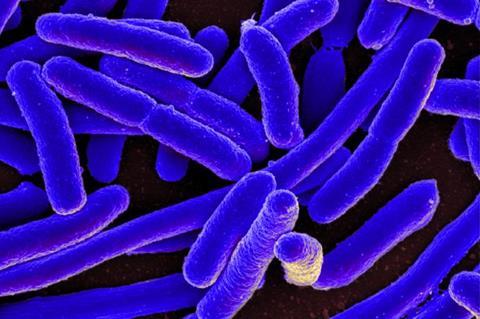E. coli bacteria may be far more capable at evolving antibiotic resistance than scientists previously thought, according to a new study published in Science.

Led by SFI External Professor Andreas Wagner, the researchers experimentally mapped more than 260,000 possible mutations of an E. coli protein that is essential for the bacteria’s survival when exposed to the antibiotic trimethoprim.
Over the course of thousands of highly realistic digital simulations, the researchers then found that 75% of all possible evolutionary paths of the E. coli protein ultimately endowed the bacteria with such a high level of antibiotic resistance that a clinician would no longer give the antibiotic trimethoprim to a patient.
Broader implications
“In essence, this study suggests that bacteria like E. coli may be more adept at evolving resistance to antibiotics than we initially thought, and this has broader implications for understanding how various systems in evolutionary biology, chemistry, and other fields adapt and evolve,” says Wagner, an evolutionary biologist at the University of Zurich in Switzerland.
Besides uncovering new and potentially worrisome findings about antibiotic resistance, the researchers’ work also casts doubt on a longstanding theory about fitness landscapes. These genetic maps represent how well an organism — or a part of it, like a protein — adapts to its environment.
On fitness landscapes, different points on the landscape represent different genotypes of an organism, and the height of these points represents how well each genotype is adapted to its environment. In evolutionary biology terms, the goal is to find the highest peak, which indicates the fittest genotype.
Rugged fitness landscapes
Prevailing theory regarding fitness landscapes predicts that in highly rugged landscapes, or those with multiple peaks of fitness, most evolving populations will become trapped at lower peaks and never reach the pinnacle of evolutionary adaptation.
However, testing this theory has been exceedingly difficult until now due to the lack of experimental data on sufficiently large fitness landscapes.
To address this challenge, Wagner and colleagues used CRISPR gene editing technology to create one of the most combinatorially complete fitness landscapes to date for the E. coli dihydrofolate reductase (DHFR) protein.
What they found was surprising. The landscape had many peaks, but most were of low fitness, making them less interesting for adaptation. However, even in this rugged landscape, about 75% of the populations they simulated reached high fitness peaks, which would grant E. coli high antibiotic resistance.
Re-evaluation of models
The real-world implications are significant. If rugged landscapes like this are common in biological systems, it could mean that many adaptive processes, such as antibiotic resistance, may be more accessible than previously thought.
The result could ultimately lead to a re-evaluation of theoretical models in various fields and prompt further research into how real-world landscapes impact evolutionary processes.
“This has profound implications not only in biology but beyond, prompting us to reevaluate our understanding of landscape evolution across various fields,” Wagner says. “We need to shift from abstract theoretical models to data-informed, realistic landscape models.”







No comments yet